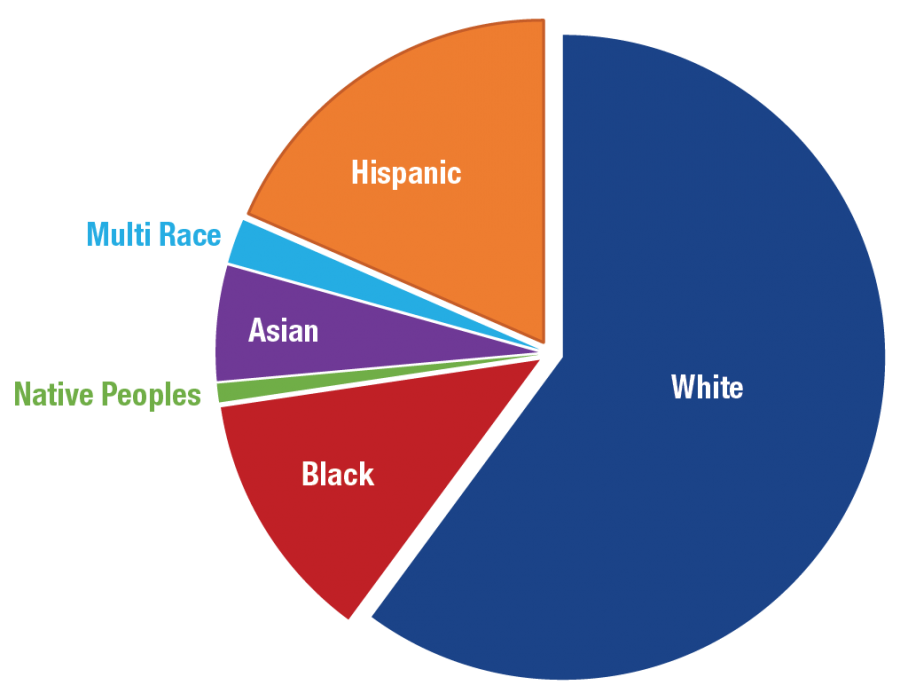The Changing Demographics of the United States Electorate
February 26, 2021
The demographics of the United States electorate are shifting, with major implications for the future of both the Democratic and the Republican parties. Minority populations are growing, rural areas are losing their inhabitants, and religion is becoming far less relevant in politics. The growing sway minorities hold over elections means that Democrats will no longer be able to take their vote for granted. Instead, they’ll have to listen to what minority voters want. To stay viable, the Republican Party must also change: it currently represents an ever-shrinking share of the electorate, and they must adapt to a changing country. By working to defend civil rights, the Republicans can gain a large share of the minority vote. Alternatively, a Trump-worshipping personality cult could be viable in the short term, but would not be sustainable.
The U.S. Census Bureau predicts that between 2040 and 2045, the United States will become a majority-minority country. Though white people have always been a majority in the United States, and they will remain the largest racial group, there will be more Hispanic, Black, Asian, and Native American people combined than white people.
Religion, particularly Christianity, is also becoming less relevant in politics. Currently, 64% of American voters self-identify as members of a Christian denomination, down from 80% in 2008. The Republican Party has gone from 87% to 79% self-identified Christians, while the Democratic Party has seen Christian representation decrease from 73% to 52%. Religious groups are often used as scapegoats, but as their relative populations increase, so too will acceptance. For example, people are less likely to support the Muslim ban if they know Muslim people. Islam remains the fastest-growing religious group, but atheists make up 28% of the electorate and 38% of the Democratic base.
The environment in which people live is also a significant predictor of party affiliation. Compared to their urban counterparts, rural voters tend to be white and less educated, but more evangelical than their urban counterparts; they tend to vote Republican. Conversely, urban voters tend to be less evangelical but more diverse, educated, and well-off. Declining birth rates and a growing exodus from rural areas are causing an increase in urban dwellers. At the same time, increased immigration is leading to the racial diversification of rural areas.
The modern Republican Party is built to represent the interests of plutocrats and politicians themselves. It maintains enough supporters to control the government with some degree of legitimacy, despite representing a minority of the American people. Its platform is more populist than policy-based, and the party is in large part supported by groups like the Christian Right and less well-off white people who vote against their own interests in the hope that action will be taken against some scapegoat.
The Democratic Party takes liberal views and is more grounded in reality than the GOP. Additionally, it generally represents its voters’ interests over those of its donors. Because those whose needs the Democratic Party fails to address often can not organize to demand change from their elected representatives, the Democratic Party is slow to act. Today, the party’s base is majority-white but includes a significant proportion of the United States’ urban and minority population.
Demographics, however, are not fate; they cannot be substituted for organization and turnout. For example, gender remains one of the deciding factors in elections, in part because women tend to lean Democratic and vote more than men. Gender is thus a crucial example of the power of voter turnout. Likewise, the state of Georgia has been considered solidly Republican since 1996. The Democrats were able to flip the state this election cycle through organization and turnout, rather than waiting for demographic change.
Demographic trends herald a more diverse America and will bring about significant shifts in politics. A demographics-mediated Democratic majority has obstacles: a growing coalition of Republican minority voters, voter suppression efforts, and other factors influencing turnout may lessen the increase in support Democrats have long held to be guaranteed. The increased representation will also give minorities greater power over policy, meaning that the Democratic Party will have to adapt to maintain minority support. To remain in power, Democrats must take more direct action with results to show for it, and start using identity politics to work with minorities—rather than as a signifier of wokeness.
At the same time, these shifts create both the need and opportunity for significant change within the Republican Party. Several studies show that a perceived loss of dominant status could push white voters further to the right and boost turnout, but this isn’t enough to keep the Republican Party afloat. If the GOP can cooperate with Democrats to work on civil rights, however, it could gain significant minority support. Failing that, Republicans are well-placed to forego policy and become a Trump-worshipping personality cult; this would allow them to maintain power for a while, but is not sustainable in the long run. The former path also requires decreased racism from the GOP and the defusal of extremist Trumpism, both of which will meet significant resistance from many Republicans. As such, it is incredibly unlikely
There is evidence that all of these things are already happening. Georgia turned blue in 2020, in large part because former gubernatorial candidate and grassroots organizer Stacey Abrams used identity politics constructively. Parts of the Democratic caucus have become more vocal about passing Medicare for All and the Green New Deal. On the other side of the aisle, the GOP is already splitting. As Don Jr. proclaimed to a crowd of eager terrorists, “This isn’t their Republican Party anymore. This is Donald Trump’s Republican Party.” At the same time, a small but growing group within the GOP is distancing itself from Trump, with several Senators and Representatives voting to impeach and convict him of inciting an insurrection at the Capitol. However, little to none of this will come to fruition without work. Demographics, again, are not fate. All the predictions made in this article depend on some level of organization. Conversely, with enough coordination or voter suppression, any claim made here could be undone.









